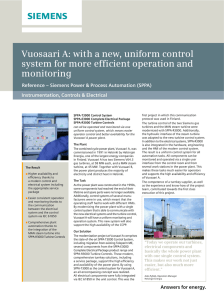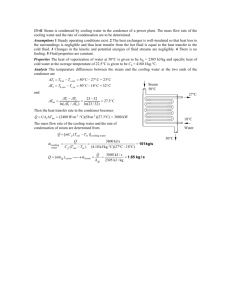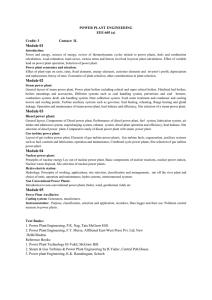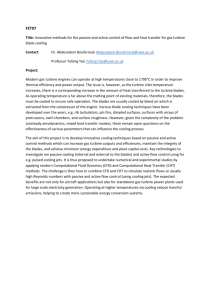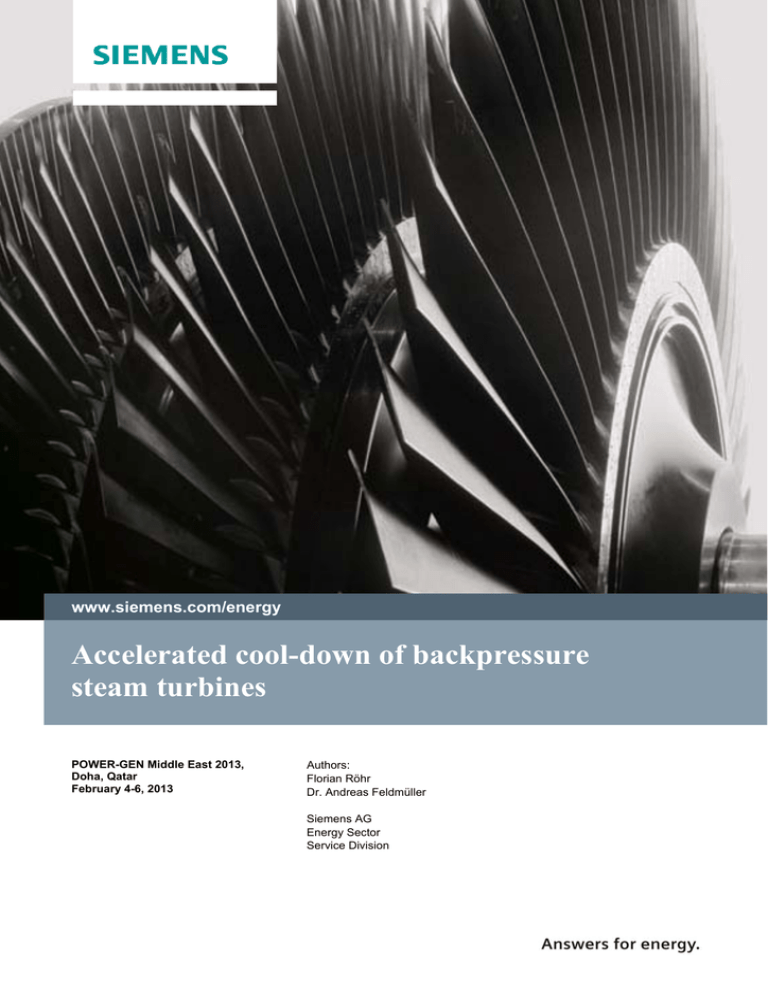
www.siemens.com/energy
Accelerated cool-down of backpressure
steam turbines
POWER-GEN Middle East 2013,
Doha, Qatar
February 4-6, 2013
Authors:
Florian Röhr
Dr. Andreas Feldmüller
Siemens AG
Energy Sector
Service Division
Table of Contents
1
Introduction ............................................................................................................ 3
2
Forced cooling for condensing steam turbines....................................................... 3
2.1
Procedure for scheduled outages............................................................................ 5
2.2
Procedure for unscheduled outages........................................................................ 6
3
Forced cooling for backpressure steam turbines .................................................... 6
3.1
Test results.............................................................................................................. 9
3.2
Conclusion............................................................................................................ 11
4
Disclaimer ............................................................................................................ 13
AL: N; ECCN: N
© Siemens AG 2012. All rights reserved.
Page 2 of 14
1 Introduction
Minimizing the duration of scheduled and unscheduled outages is becoming more and more
important, especially for desalination plants. The turboset, with its hot components in the
steam turbine, features long cool-down times of up to 12 days before the shaft can be put into
standstill condition. Standard solutions like forced cooling used for condensing turbines
cannot be adapted without major modifications.
Siemens has recently implemented a forced cooling procedure for backpressure turbines to
shorten cool-down times by more than 50 percent. Test results will be presented in this paper.
By using this procedure, plant operators are able to have earlier access to areas of the steam
turbines, generator, and auxiliary systems that require a shaft standstill, which increases the
availability of the plant.
2 Forced cooling for condensing steam turbines
Forced cooling for condensing steam turbines was developed in the early 1990s for specific
units, especially for the high number of newly built single-shaft power trains. In this
application, the gas turbine is aligned with the steam turbine on one shaft with a generator in
the middle. This configuration, with many advantages in a variety of areas (like compact civil
arrangements), created challenges in terms of operation and maintenance. The gas turbine’s
lighter design results in a much shorter cool-down period than that of its solid counterpart on
the other end of the shaft, the steam turbine. That can cause situations where necessary gas
turbine inspections are delayed simply because the steam turbine must first cool down in
order to put it into standstill and so ensure a safe work environment with no rotating masses.
To avoid excessive thermal distortion and differential expansion of the steam turbine,
maximum allowable cool-down gradients are determined using a finite element computer
model and considering material strength limits and usage factors. Exceeding these steam
turbine specific cool-down gradients could cause extensive damage. To monitor the cooldown gradients, existing temperature measurements of the steam turbine are used to help
maintain the recommended temperature limits during a forced cool-down.
During forced cooling, the existing condenser-air removal system is used to draw air from the
turbine hall through the blade path of the turbines into the condenser, where it is ultimately
exhausted from the system. This flow generates a forced heat transfer from the hot steam
AL: N; ECCN: N
© Siemens AG 2012. All rights reserved.
Page 3 of 14
turbine components to the heated air, which allows the steam turbine to cool down much
faster than through natural cooling.
Fig. 1: Cooling path in condensing steam turbine
Therefore, forced cooling is a reliable way of reducing cool-down times by more than 50
percent compared with natural cooling. The forced cooling process combines a modified
software package, nozzle filters, and the mechanical analysis of permissible relative
expansions. The permanent installation of additional hardware or modification of existing
hardware is not required. In case of usage, the nozzle filters need to be installed on the
existing flanges for the dehumidifiers between the emergency stop and control valves of HP
and IP turbine.
Forced Cooling can be differentiated into two operational application areas, whether it is used
for scheduled or unscheduled outages.
AL: N; ECCN: N
© Siemens AG 2012. All rights reserved.
Page 4 of 14
Fig. 2: Application areas of forced cooling
2.1
Procedure for scheduled outages
Prior to the plant shutdown, the main steam and reheat steam temperatures are reduced (Phase
1) to the minimum allowable values in accordance with allowable limits and protection
criteria. Reducing the temperature during operation shortens the overall cool-down time due
to the lower starting temperature of the forced cooling process. The on-load cool-down with
steam allows higher gradients than later on with air. In addition, the steam turbine is available
for the load dispatcher at that time.
In Phase 2, when steady-state temperature conditions have been achieved with reduced steam
temperatures, the steam turbine is shut down. During turning-gear operation the turbine enters
a so-called “natural cooling phase.” During this period the inner shaft and casing temperatures
are equalizing throughout the entire steam turbine. As soon as the equalization has reached
steady-state conditions, the forced cooling can be started.
During this period of “natural cooling,” the boiler is depressurized and isolated from the
steam turbine. In addition, the nozzle filters are installed at the dehumidifier flanges between
the emergency stop and control valves.
In Phase 3, the control valves are opened and the vacuum pumps switched on. This draws in
ambient air via the nozzles through the turbine blade path and cools down the components
AL: N; ECCN: N
© Siemens AG 2012. All rights reserved.
Page 5 of 14
smoothly. To maintain the allowable cool-down gradient, the air flow is regulated by
changing the position of the control valve.
When reaching shaft temperatures below 100°C (212°F) the turning gear can be switched off,
and the turbine is in safe condition for all required maintenance activities on the turbines,
generator, and auxiliary systems.
2.2
Procedure for unscheduled outages
In the event of an unscheduled outage (for example, in case of a turboset trip) or if there are
no desuperheating options for the steam generator, the on-load reduction of steam
temperatures described in Phase 1 cannot be performed.
In this case, Phase 2 (natural cooling) and Phase 3 (forced cooling with air) will be extended
for several hours to compensate the missing Phase 1.
3 Forced cooling for backpressure steam turbines
In 2010 the first idea for a forced cooling process for backpressure steam turbines surfaced
and a general concept was developed. The pilot implementation was performed in a
desalination plant on the Arabian Peninsula and was finalized in 2012. The crude-oil fired
desalination plant consists of three turbosets with an electrical power output of approximately
430 MW per unit. The total plant is capable of producing 880,000 m³ of drinking water per
day. Each turboset comprises a high-pressure turbine (150 bar, 510° Celsius), a two-flow
intermediate pressure turbine (40 bar, 460° Celsius), and a 500-MVA hydrogen-cooled
generator with static excitation.
Due to the high water and electricity demand in the region, it was the customer’s goal to
shorten the plant outage times. The fact that the steam turbine required more than 12 days to
reach a standstill condition of below 100° Celsius shaft temperature when cooling down
naturally needed to be addressed. Basically, the forced cooling procedure for condensing
steam turbines can also be applied for backpressure steam turbines. The challenge is to
provide a suitable external suction blower unit (instead of the not existing evacuation system
of the condenser) that has sufficient capacity and is capable of processing hot air, especially at
the beginning of the procedure. Another requirement was the mobility of the suction unit and
its installation, because it should be used for all three units. Due to the design of high (HP)
and intermediate (IP) pressure turbines at the pilot plant, two suction units were required.
AL: N; ECCN: N
© Siemens AG 2012. All rights reserved.
Page 6 of 14
Each suction unit had to ensure that the required vacuum was achieved so that appropriate
cooling flow in the turbine was established.
For the suction unit, the choice was made to use a rotary blower with high energy efficiency,
low pulsation characteristics, a robust design, and a long service life. With a motor power of
more than 70 kW and its speed-controlling capability, the suction capacity was sufficient for
the application purpose. The blower was built in an encased, fan-cooled skid design, which
allows easy mobile handling and reduces noise emissions when in operation.
Each rotary blower must be easy to connect to the operational piping, taking into account the
calculated cross-sections of the piping, structural stiffness against the vacuum, and process
temperatures during the procedure. The connection points must have been selected to provide
fast accessibility and adequate space for the blower skid.
Fig. 3: Forced cooling concept for backpressure steam turbines
For the HP turbine, a flange access on the HP dump line was chosen, with the advantage of
being able to install the blower skid on the 0 m plant level without the need of cranes.
AL: N; ECCN: N
© Siemens AG 2012. All rights reserved.
Page 7 of 14
Unfortunately, it was not possible to gain access in front of the HP dump valve, simply
because it is positioned in between the 6 and 12 m floor and no flanges are available. The skid
can be brought into position with a simple jack lifter. The connection is still relatively close to
the HP turbine and ahead of the cold reheat flap, which itself builds up a “vacuum barrier” to
the rest of the reheat piping.
The HP dump line ends in an atmosphere opening for dumping purposes in case of a steam
turbine trip. In order to create the vacuum, the atmospheric end of the HP dump line must be
closed. For safety reasons, it was decided to not simply cover the exhaust on the machine hall
roof, because the cap might be forgotten when the plant is restarted. Instead, a dummy piece
was installed in the HP dump line farther upstream at an easily accessible position close to the
12 m turbine floor. When the forced cooling occurs, the dummy piece will be removed from
the HP dump line, and the consequent opening in the pipe will be covered with the flange
from 0 m at the downstream side. In this way it is guaranteed that vacuum can be pulled
without openings to the atmosphere and the safety aspect is fulfilled not to forget the cover
plate in a case of restarting the plant in places like the roof, where it could be easily
overlooked.
An access point to the IP turbine was selected close to the process steam line that connects the
IP turbine with the desalination units. The access point uses a seal steam connection line,
which was easy to modify for the forced cooling purpose. This access position is close to the
IP turbine and therefore permits a close and thus an efficient evacuation of the IP turbine. The
large process steam flap in closed position acts as a barrier to the enormous volume in the
process steam line and it’s connected desalination modules. The start-up and safety valve that
connects the process steam line with the atmosphere can be easily closed for this purpose to
avoid air ingress. The existing platform of the left-side IP control valve needs to be extended
marginal, but offers a close position of the rotary blower and therefore short connection pipes.
The power supply and control cabinet for the blower units were installed in a fixed position
close to the blower operating positions. Due to the mobility concept involving all three
turbosets, six power and supply cabinets in total were installed in the plant. The air-cooled
cabinets provide the 380-V power supply via a frequency converter. The power supply itself
is fed by the plant’s low-voltage distribution. It is possible via the frequency converter to
regulate the speed of the rotary blower. This is necessary because the blower can only be
operated in certain temperature limits before its motor protection will be actuated. The
AL: N; ECCN: N
© Siemens AG 2012. All rights reserved.
Page 8 of 14
exhaust temperature is used for a control loop. If it exceeds a certain limit, the speed is
throttled to allow a decrease in temperature. To handle the high temperatures at the suction
blower inlet, especially at the beginning of the forced cooling procedure, the up-heated air
coming from the turbine is mixed with ambient air via a manually operated valve. This
ensures an admissible inlet temperature for the blower at all times. In addition, the rotary
blower is protected by a differential pressure measurement.
Fig. 4: Suction blower concept
In the initial phase of evacuating the HP and IP turbine with the suction blower units, the
forced cooling procedure is basically the same as described in the standard forced cooling for
condensing turbines in Chapter 1.
The cooling air mass flow is controlled by the position limiter of the control valves in the
plant control room to keep the maximum allowable cooling gradient. The solution for
backpressure turbines also offers the option of influencing the cooling gradient through the
ingress of bypass air – within the limits of the operating range of the rotary blower.
3.1
Test results
The tests were performed in the pilot plant’s scheduled yearly outage. The prefabricated
piping was welded and adapted to site requirements during this time. The installation of the
cabinets and their cabling was already complete when the units were still in operation. The
commissioning of the blower units was carried out without major problems, and several tests
AL: N; ECCN: N
© Siemens AG 2012. All rights reserved.
Page 9 of 14
were performed. Diagram 1 shows the test results from the cool-down during the pilot
implementation.
Diagram 1: Test results
The blue line (HP nat) symbolizes the natural cool-down of the HP shaft recorded during the
initial commissioning. Compared to the natural cooling, the red line (HP FC) represents the
result from the forced cool-down of the HP shaft. The green line (IP FC) illustrates the forced
cool-down of the IP shaft. The binary information of the blowers’ operation (HP/IP Fan On)
can be seen by the grey lines, where 100 percent represents “On” and 0 percent ”Off.” The
position of the control valves is also shown by the orange (HP CV) and light green (IP) lines.
The required natural cool-down phase of at least 12 hours after shutdown was used effectively
to prepare for the tests and to install the air nozzles between the emergency stop and control
valves. Due to manpower restrictions during the tests, the installation and successive
operation of the blowers took place sequentially, starting with the HP blower due to the higher
temperatures.
During the first tests it became obvious that maintaining the maximal allowable cooling
gradients could be influenced most effectively by adjusting the manual bypass valve upstream
of the blowers – which explains why both the HP and IP control valves in Diagram 1 were
opened fully when starting the HP and later the IP blower.
AL: N; ECCN: N
© Siemens AG 2012. All rights reserved.
Page 10 of 14
3.2
Conclusion
The measured cool-down times were very impressive. The HP shaft achieved temperatures
below 100° Celsius within 76 hours, and the IP shaft within 82 hours due to the later startup
of the suction blower. Taking the total process of a natural cool-down into account, Diagram
2 illustrates the achievement in a more tellingly way.
Diagram 2: Test results compared to natural cooling
Compared to the 12 days of natural cooling, the benefit of forced cooling is obvious, with 3. 2
days for the HP shaft and 3.4 days for the IP shaft. These results still show room for further
optimization: All participants in testing process were convinced that it will be possible to cool
down all shafts in less than three days.
With “forced cooling for backpressure turbines,” it is possible to easily reduce cool-down
times by 50 percent at the minimum. The test results show that a reduction down to 25 percent
of the normal cool-down time can be achieved. In this scenario, the customer would be able to
avoid nine days of outage time and profit from this advantage, whether by fulfilling more
demand for electricity and drinking water.
With this example, Siemens has proven once again to be a reliable partner for plant
optimization.
AL: N; ECCN: N
© Siemens AG 2012. All rights reserved.
Page 11 of 14
This is not just the case for standard plant configurations, but also for individually designed
plants with special design features like the desalination plants described in this paper.
AL: N; ECCN: N
© Siemens AG 2012. All rights reserved.
Page 12 of 14
4 Disclaimer
These documents contain forward-looking statements and information – that is, statements
related to future, not past, events. These statements may be identified either orally or in
writing by words as “expects”, “anticipates”, “intends”, “plans”, “believes”, “seeks”,
“estimates”, “will” or words of similar meaning. Such statements are based on our current
expectations and certain assumptions, and are, therefore, subject to certain risks and
uncertainties. A variety of factors, many of which are beyond Siemens’ control, affect its
operations, performance, business strategy and results and could cause the actual results,
performance or achievements of Siemens worldwide to be materially different from any
future results, performance or achievements that may be expressed or implied by such
forward-looking statements. For us, particular uncertainties arise, among others, from changes
in general economic and business conditions, changes in currency exchange rates and interest
rates, introduction of competing products or technologies by other companies, lack of
acceptance of new products or services by customers targeted by Siemens worldwide,
changes in business strategy and various other factors. More detailed information about
certain of these factors is contained in Siemens’ filings with the SEC, which are available on
the Siemens website, www.siemens.com and on the SEC’s website, www.sec.gov. Should one
or more of these risks or uncertainties materialize, or should underlying assumptions prove
incorrect, actual results may vary materially from those described in the relevant forwardlooking statement as anticipated, believed, estimated, expected, intended, planned or
projected. Siemens does not intend or assume any obligation to update or revise these
forward-looking statements in light of developments which differ from those anticipated.
Trademarks mentioned in these documents are the property of Siemens AG, its affiliates or
their respective owners.
AL: N; ECCN: N
© Siemens AG 2012. All rights reserved.
Page 13 of 14
Published by and copyright © 2012:
Siemens AG
Energy Sector
Freyeslebenstrasse 1
91058 Erlangen, Germany
Siemens Energy, Inc.
4400 Alafaya Trail
Orlando, FL 32826-2399, USA
For more information, please contact
our Customer Support Center.
Phone: +49 180/524 70 00
Fax:
+49 180/524 24 71
(Charges depending on provider)
E-mail: support.energy@siemens.com
All rights reserved.
Trademarks mentioned in this document are
the property of Siemens AG, its affiliates,
or their respective owners.
AL: N; ECCN: N
Subject to change without prior notice.
The information in this document contains
general descriptions of the technical options
available, which may not apply in all cases.
The required technical options should therefore
be specified in the contract..
© Siemens AG 2012. All rights reserved.
Page 14 of 14

